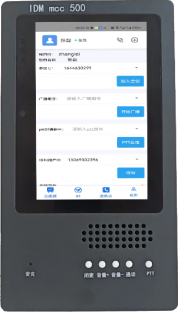IDM MCC500 Audio and Video Communication Terminal
IDM MCC500 Audio and Video Communication Terminal
I Overview
The IDM MCC500 Audio and Video Communication Terminal is a 7-inch touch all-in-one device with high-performance configuration, capable of meeting the demands of audio and video dispatching. It can be widely used in various scenarios such as duty room audio and video intercom, access control card visual intercom, desktop visual intercom terminals, elevator intercom duty hosts, vehicle-mounted audio and video terminals, and wall-mounted audio and video terminals. Additionally, it can be integrated with SIP soft switch systems, unified communication dispatch systems, and network broadcasting systems for networking applications.

The IDM MCC500 Audio and Video Communication Terminal is capable of running IDM audio and video phone terminal software, which provides SIP soft switch phone call functionality, including audio calls, video calls, visual conferencing, message sending and receiving, and PTT (Push-to-Talk) intercom.
Equipped with a 5-megapixel camera, the IDM MCC500 Audio and Video Communication Terminal can also perform audio and video access and forwarding functions, enabling video surveillance, video conferencing, and other capabilities.
II Product Specifications and Parameters
|
Structural Parameters |
Functionality and Performance |
Mainboard Performance |
|
Installation Method l The back of the device features a 70mm*70mm mounting hole, compatible with standard monitor mounting brackets on the market. It can be used with desktop stands, wall mounts, etc. l The product is primarily designed for portrait installation, similar to the typical use of mobile phones. l The device can also be used in landscape orientation, similar to the usage of a computer. |
Touch Screen and Display l 7-inch touch display with a physical resolution of 1280x800. l Supports HDMI external connection, enabling dual-screen display with different content. l MIPI-DSI-40PIN-FPC supports a maximum output of 1200x1920. l HDMI 2.0 supports a maximum output of 4K@60Hz. l One dual-eight LVDS + backlight interface supports a maximum output of 1920x1080. |
CPU l Quad-core 2.0GHz. GPU l ARM G52 2EE, supporting OpenGL ES 1.1/2.0/3.2, OpenCL 2.0, Vulkan 1.1, and embedded high-performance 2D acceleration hardware. NPU l Supports 0.8T computing power. |
|
Appearance Features l 5mm thick narrow bezel design, giving the product an elegant appearance. l 8Ω 5W speaker output on the front, providing loud and clear sound. l The panel has 5 physical buttons, ensuring quick response at any time. l The panel includes a microphone pickup hole, providing clear audio capture. |
Power Supply l The device uses a 12V2A DC power adapter and can be customized for POE (Power over Ethernet) power supply mode. |
Memory and Storage l 2GB/4GB LPDDR; EMMC - 8GB/16GB/32GB, configurable based on user needs. |
|
Dimensions l 25.5*14.4*23mm. l RJ45 Interface
l 10M/100M/1000M adaptive. |
Wireless Communication l WiFi 2.4G. l BT 4.1. |
Multimedia l 4KP60 H.265/H.264/VP9 video codec. l Supports 1080P 100fps H.265/H.264 video encoding. |
|
System Software l The device runs on Android 11. l It can be customized with a Linux version. |
Expansion Interfaces l 2 TTL serial ports, 1 Debug serial port. l 1 I2C interface. l 4 general-purpose GPIO ports. l 1 remote control, 1 red LED, 1 green LED. |
8M Built-in High Dynamic Range Image Signal Processor |
三 Terminal Software Functions
(1). One-to-One Audio and Video Calling: Enables superiors to call subordinates and vice versa.
(2). One-to-Many Audio and Video Conferencing: Conducts audio and video conferences with preset "subordinate conference groups."
(3). Video Monitoring of Subordinates: Provides video surveillance of subordinate units.
(4). Audio Monitoring of Subordinates: Facilitates audio surveillance of subordinate units.
(5). Management of Local "Preset Conference Group" Members: Supports adding, deleting, modifying, and querying members.
(6). Conference Member Management: Includes functions such as muting, inviting members to speak, and facilitating free discussion during the conference.
(7). Ad-Hoc Selection for Audio and Video Calling: Allows temporary selection of several subordinate units for audio and video calls.


















 86-18710178699
86-18710178699  xufei@rdtcom.com
xufei@rdtcom.com